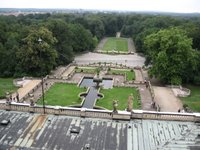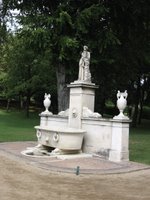Potsdam is a ‘capital outside the capital’ of the Prussians, now located on the outskirts of Berlin. The Prussian kings built numerous castles and buildings around a garden now called the Sanssouci Park. After successive expansions of the park and construction works, the park is now home to 20 or so buildings for the royals. One of my friends wondered if everyone in the royal family was fortunate enough to occupy each of these buildings.
We entered the park from the west, and we first visited the New Palace (Neues Palais). With its polished marble floor, we had to put on their special slippers when walking inside the palace – it’s actually not so much walking but feels more like ice-skating! One of the most memorable parts inside the palace was a grand ballroom decorated with sea shells on all its walls. Just imagine how cool it would be to hold a party there with an underwater theme! It’s a pity I can’t share any photos here because photography was forbidden, so you should see it for yourself!
After the New Palace, we walked through the woods of Sanssouci Park until we reached the Orangerie palace, which was built on the top of a small hill. The garden of the Orangerie was terraced and each level was decorated differently, providing a different view when looking uphill from the foot of Orangerie and when looking downhill from the top of palace. The interior décor of the Palace was not particularly remarkable compared to other palaces, but its gallery was noteworthy for where the pictures originated. One of the kings was a fan of Raffaelo’s paintings (Raffaelo is one of the most famous artists of the Renaissance era), but the poor king could not afford the originals! He asked other artists to make exact copies of the masterpieces, and he got pretty good value for his money too! Lucky he lived in an age before copyright laws existed …
The Sanssouci Park would not be so-named without a Sanssouci Palace. Unfortunately we had to dash back to Berlin Central Station so that I could catch a train back to Munich in time. We only had a look of the Sanssouci Palace from the outside and walk through the terraced gardens outside the palace on the way out.
Money is already a ‘problem’ from the days when the king could only afford replicas of paintings. A more serious and visual problem, however, is the maintenance of the buildings. For example, the cracks in the walls of the New Palace and its general upkeep speak of how little attention and resources had been directed to its maintenance. Who knows whether it is because the former East German government was too poor to care, or now there is inadequate state funding or proceeds from admissions. The Sanssouci Park is often touted as the Versailles of Germany, but its run-down state is just no match to its French counterpart. All three of us felt somewhat disappointed by this, and what a pity as Sanssouci is a UNESCO cultural heritage. I hope the authorities are working hard to restore the whole park and the palaces to its former glory!
在柏林外圍的波茨坦,是普魯斯帝國的另一個據地。歷任皇帝不斷把公園擴充,又興建宮殿及其他建築物,一個本來不見很大的忘憂園,便有十來二十間房舍,我的朋友不禁問,是否皇室人人有份,一人一間?
我們從忘憂園西面而入,先參觀新宮殿(Neues Palais),由於全宮地板都由雲石鋪成,入內就得套穿特別的拖鞋,走路時就像滑冰。新宮殿最獨特之處,要算是牆壁由多種貝殼鋪砌的大廳,令人有置身海底之感,試想在那裡開舞會的情調!可惜宮內不准拍攝,大家祇好親身感受了。
從新宮殿走出來,穿過忘憂園的園林,便到建在小山上的橙宮(Orangerie),橙宮的花園從山腳到山上分成數層,每層佈置各有心思,不論從下仰望,或從橙宮之頂瞭瞰,都有不同的層次感。宮內裝飾比其他宮殿無太大特色,不過值得一提的是畫廊,收藏了某皇帝的心頭好——拉斐爾·桑喬的作品(拉斐爾·桑喬乃文藝復興年代的名畫家),但皇帝並非最有錢之輩,真品付擔不起,便命人抄畫,實行低消費享受。皇帝生活在沒有版權法的年代,真好!
忘憂園當然有個忘憂宮(Sanssouci Palace),不過我們時間匆匆,祇是在外圍繞了一圈,便經由宮外梯田式的花園離開,趕搭火車到柏林火車總站,好讓我準時回慕尼黑。
談到錢,便不得不提宮殿的保養,不知是前東德政府窮,還是現在經費及門票收入不足,新宮殿的日久失修,從牆角及牆身的裂紋,以至整體的粉飾都可見一斑,我們一行三人,都不約而同認為,忘憂園縱然被稱為柏林的凡爾塞宮,卻遠遠比巴黎的失色。忘憂園貴為聯合國文化遺產,真的要加把勁!
Date of Visit: 15 August, 2006 參觀日期:2006年8月15日
Neues Palais - the exterior 新宮殿外貌




The Orangerie and its Gardens 橙宮及其花園






Sanssouci Palace and its Garden 忘憂宮及其花園




And for some memories that we can 'hang' onto in Potsdam ...
還有波茨坦令人「掛」念的見聞......


... like the rhino dangling in mid-air (left) and the barbecue hawker hanging a griller around his neck (right)!
包括半天吊的犀牛(左)及把燒烤爐掛在脖子,賣燒烤的小販
We entered the park from the west, and we first visited the New Palace (Neues Palais). With its polished marble floor, we had to put on their special slippers when walking inside the palace – it’s actually not so much walking but feels more like ice-skating! One of the most memorable parts inside the palace was a grand ballroom decorated with sea shells on all its walls. Just imagine how cool it would be to hold a party there with an underwater theme! It’s a pity I can’t share any photos here because photography was forbidden, so you should see it for yourself!
After the New Palace, we walked through the woods of Sanssouci Park until we reached the Orangerie palace, which was built on the top of a small hill. The garden of the Orangerie was terraced and each level was decorated differently, providing a different view when looking uphill from the foot of Orangerie and when looking downhill from the top of palace. The interior décor of the Palace was not particularly remarkable compared to other palaces, but its gallery was noteworthy for where the pictures originated. One of the kings was a fan of Raffaelo’s paintings (Raffaelo is one of the most famous artists of the Renaissance era), but the poor king could not afford the originals! He asked other artists to make exact copies of the masterpieces, and he got pretty good value for his money too! Lucky he lived in an age before copyright laws existed …
The Sanssouci Park would not be so-named without a Sanssouci Palace. Unfortunately we had to dash back to Berlin Central Station so that I could catch a train back to Munich in time. We only had a look of the Sanssouci Palace from the outside and walk through the terraced gardens outside the palace on the way out.
Money is already a ‘problem’ from the days when the king could only afford replicas of paintings. A more serious and visual problem, however, is the maintenance of the buildings. For example, the cracks in the walls of the New Palace and its general upkeep speak of how little attention and resources had been directed to its maintenance. Who knows whether it is because the former East German government was too poor to care, or now there is inadequate state funding or proceeds from admissions. The Sanssouci Park is often touted as the Versailles of Germany, but its run-down state is just no match to its French counterpart. All three of us felt somewhat disappointed by this, and what a pity as Sanssouci is a UNESCO cultural heritage. I hope the authorities are working hard to restore the whole park and the palaces to its former glory!
在柏林外圍的波茨坦,是普魯斯帝國的另一個據地。歷任皇帝不斷把公園擴充,又興建宮殿及其他建築物,一個本來不見很大的忘憂園,便有十來二十間房舍,我的朋友不禁問,是否皇室人人有份,一人一間?
我們從忘憂園西面而入,先參觀新宮殿(Neues Palais),由於全宮地板都由雲石鋪成,入內就得套穿特別的拖鞋,走路時就像滑冰。新宮殿最獨特之處,要算是牆壁由多種貝殼鋪砌的大廳,令人有置身海底之感,試想在那裡開舞會的情調!可惜宮內不准拍攝,大家祇好親身感受了。
從新宮殿走出來,穿過忘憂園的園林,便到建在小山上的橙宮(Orangerie),橙宮的花園從山腳到山上分成數層,每層佈置各有心思,不論從下仰望,或從橙宮之頂瞭瞰,都有不同的層次感。宮內裝飾比其他宮殿無太大特色,不過值得一提的是畫廊,收藏了某皇帝的心頭好——拉斐爾·桑喬的作品(拉斐爾·桑喬乃文藝復興年代的名畫家),但皇帝並非最有錢之輩,真品付擔不起,便命人抄畫,實行低消費享受。皇帝生活在沒有版權法的年代,真好!
忘憂園當然有個忘憂宮(Sanssouci Palace),不過我們時間匆匆,祇是在外圍繞了一圈,便經由宮外梯田式的花園離開,趕搭火車到柏林火車總站,好讓我準時回慕尼黑。
談到錢,便不得不提宮殿的保養,不知是前東德政府窮,還是現在經費及門票收入不足,新宮殿的日久失修,從牆角及牆身的裂紋,以至整體的粉飾都可見一斑,我們一行三人,都不約而同認為,忘憂園縱然被稱為柏林的凡爾塞宮,卻遠遠比巴黎的失色。忘憂園貴為聯合國文化遺產,真的要加把勁!
Date of Visit: 15 August, 2006 參觀日期:2006年8月15日
Neues Palais - the exterior 新宮殿外貌




The Orangerie and its Gardens 橙宮及其花園






Sanssouci Palace and its Garden 忘憂宮及其花園




And for some memories that we can 'hang' onto in Potsdam ...
還有波茨坦令人「掛」念的見聞......


... like the rhino dangling in mid-air (left) and the barbecue hawker hanging a griller around his neck (right)!
包括半天吊的犀牛(左)及把燒烤爐掛在脖子,賣燒烤的小販
Comments